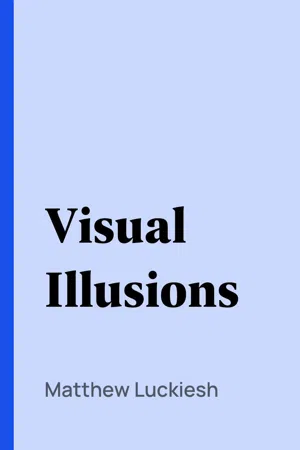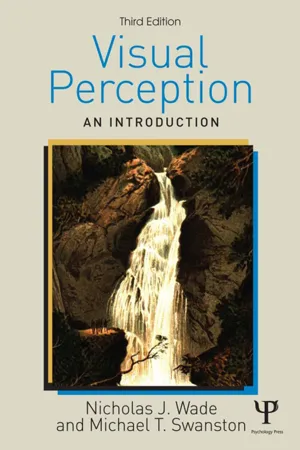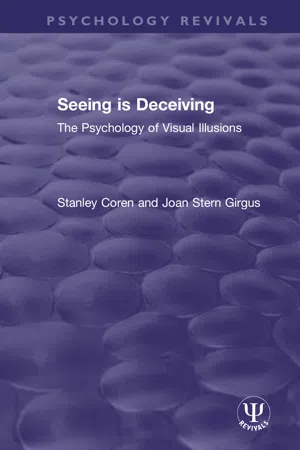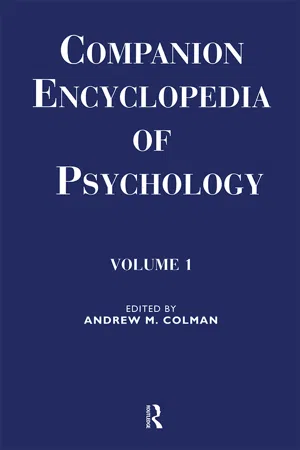Psychology
Visual illusions
Visual illusions are perceptual phenomena that occur when the brain processes sensory information in a way that differs from the physical reality of the stimulus. These illusions can involve misinterpretations of size, shape, color, or motion, leading to discrepancies between what is seen and what actually exists. They provide valuable insights into the complexities of visual perception and the brain's processing of visual information.
Written by Perlego with AI-assistance
Related key terms
Related key terms
1 of 4
Related key terms
1 of 3
4 Key excerpts on "Visual illusions"
- eBook - ePub
Visual Illusions
Their Causes, Characteristics and Applications
- Matthew Luckiesh(Author)
- 2011(Publication Date)
- Perlego(Publisher)
The explanation accepted by some is that more effort is required to raise the eyes, or point of sight, through a certain vertical distance than through an equal horizontal distance. Perhaps we unconsciously appraise effort of this sort in terms of distance, but is it not logical to inquire why we have not through experience learned to sense the difference between the relation of effort to horizontal distance and that of effort to vertical distance through which the point of sight is moved? We are doing this continuously, so why do we not learn to distinguish; furthermore, we have overcome other great obstacles in developing our visual sense. In this complex field of physiological psychology questions are not only annoying, but often disruptive.As has been pointed out in Chapter II, images of objects lying near the periphery of the visual field are more or less distorted, owing to the structure and to certain defects of parts of the eye. For example, a checkerboard viewed at a proper distance with respect to its size appears quite distorted in its outer regions. Cheap cameras are likely to cause similar errors in the images fixed upon the photographic plate. Photographs are interesting in connection with Visual illusions, because of certain distortions and of the magnification of such aspects as perspective. Incidentally in looking for illusions, difficulty is sometimes experienced in seeing them when the actual physical truths are known; that is, in distinguishing between what is actually seen and what actually exists. The ability to make this separation grows with practice but where the difficulty is obstinate, it is well for the reader to try observers who do not suspect the truth.Illusions of Interrupted Extent.—Distance and area appear to vary in extent, depending upon whether they are filled or empty or are only partially filled. For example, a series of dots will generally appear longer overall than an equal distance between two points. This may be easily demonstrated by arranging three dots in a straight line on paper, the two intervening spaces being of equal extent, say about one or two inches long. If in one of the spaces a series of a dozen dots is placed, this space will appear longer than the empty space. However, if only one dot is placed in the middle of one of the empty spaces, this space now is likely to appear of less extent than the empty space. (See Fig. 7 .) A specific example of this type of illusion is shown in Fig. 6 . The filled or divided space generally appears greater than the empty or undivided space, but certain qualifications of this statement are necessary. In a the divided space unquestionably appears greater than the empty space. Apparently the filled or empty space is more important than the amount of light which is received from the clear spaces, for a black line on white paper appears longer than a white space between two points separated a distance equal to the length of the black line. Furthermore, apparently the spacing which is the most obtrusive is most influential in causing the divided space to appear greater for a than for b. The illusion still persists in c - eBook - ePub
Visual Perception
An Introduction, 3rd Edition
- Nicholas Wade, Mike Swanston(Authors)
- 2013(Publication Date)
- Psychology Press(Publisher)
The distinction between illusions and hallucinations has often been difficult to draw. One way of separating them is to refer to the population experiencing the phenomena. Generally speaking, visual spatial illusions are seen by everyone, albeit with different magnitudes. However, if someone says that they can see an elephant in the room, this perception may not be shared by others. Thus, hallucinations can be thought of as idiosyncratic rather than universal. This simple distinction breaks down when we consider some of the oldest descriptions of states that were called hallucinations – they were referred to as subjective visual phenomena by Purkinje. Despite the fact that many of the subjective phenomena he examined had previously been described, his contribution was to classify the observations, to describe them with precision, and interpret them within the context of the then known physiology. Purkinje’s representations of these effects are shown in Figure 2.30. He described stroboscopic patterns, pressure figures, effects of galvanic stimulation, blind spot, pattern disappearances and distortions, visibility of retinal blood vessels and blood flow, afterimages, aftereffects, single and double vision, eye movements, peripheral vision, real and apparent motion, accommodation, near and far vision, and voluntary squinting. We can take stroboscopic (flickering) patterns as an example of his approach: he produced flicker by waving his fingers in front of one eye, while looking at the bright sky, and reported seeing checkerboards, zigzags, spirals, and ray patterns. They are now referred to as stroboscopic patterns although they were described before the stroboscope was invented. When the eye is stimulated by an unpatterned, flickering light, patterns of bewildering complexity become visible. They are called stroboscopic patterns after the modern form of the instrument, which can deliver pulses of light at very high frequencies. - eBook - ePub
Seeing is Deceiving
The Psychology of Visual Illusions
- Stanley Coren, Joan Girgus(Authors)
- 2020(Publication Date)
- Routledge(Publisher)
12 The Psychoanatomy of Visual illusionsIn the preceding eight chapters we have been confronted with a multitude of mechanisms, structural processes, and judgmental and information processing strategies, all of which have been proposed to explain Visual illusions. In some respects, their number and diversity is almost overwhelming. It is clear that these distorting agents may introduce themselves in any stage in the perceptual process. Some of them seem to act as early as the initial formation of the optical image on the retinal surface, whereas others wait almost until the final formation of the conscious representation of the stimulus (Girgus & Coren, 1973a). In addition, many of the illusion configurations we have discussed seem to offer the opportunity for more than one mechanism to operate. For instance, when the stimulus array contains converging lines that intersect to form an angle, contributions to the resulting distortion may arise from factors associated with optical blur, lateral neural interactions on the retina, lateral interactions in the cortex, or judgmental strategies that treat the angle as if it were a perspective cue or an enclosing frame. It is possible that all these mechanisms play a role whenever such an array is present or that one particular source of distortion predominates in a given configuration, depending on the nature of the accessory lines and their relationship to the test elements.It is, however, possible to bring some order to this exceedingly complex situation if we begin by accepting the notion that many different mechanisms may interact to form any given illusory distortion. Once having accepted this premise, it is appropriate to shift the focus of our inquiry so that we no longer try to find one lone causal agent for any given distortion. Rather, we must try to determine what contribution each mechanism and processing level makes to the final illusory percept. In some ways, our task is similar to that of the biologist or physiologist who wishes to determine how several mechanisms interrelate to sustain some life process. Since most bodily functions are sequential, biologists and physiologists frequently use a research paradigm whereby the process is interrupted or stimulated at varying stages in order to ascertain what functions take place before or after the point of intervention. In many respects, when considering the formation of Visual illusions, we are engaged in an analogous task. It is certainly the case that we are looking at a visual system that processes information sequentially, beginning with the peripheral optics and moving on through the retinal neural substrate and visual pathways up to the visual cortex. Unfortunately, beyond the primary visual cortex, the strict sequential nature of the system seems to disappear. Our task differs from that of the biologist, moreover, since we wish to dissect a phenomenal experience rather than a physical entity. All indications about the nature of the system must come solely through behavioral indices that indicate changes in the conscious experience. We may be said to be engaged in a form of psychoanatomy - eBook - ePub
Companion Encyclopedia of Psychology
Volume One
- Andrew M. Colman(Author)
- 2018(Publication Date)
- Routledge(Publisher)
Figure 4e is the Ponzo illusion (top) and the Poggendorf (bottom) Some aspects of perception can be understood if we know about the coding of features, as in colour vision or the elementary contour elements as studied by Hubel and Wiesel. Others require an understanding of how different cues, to depth and distance for instance, interact to affect what is seen (Figure 5). Still others, like the distorted room, require us to consider how our habits of thought and expectations-unconscious inferences-determine what we see. The study of illusion is like a workshop for the meshing together of all the different sorts of influence that bear on perception. Figure 5 Two illusions of size, induced by context; the one case by perspective (giving a false impression of distance, so "size constancy" is operative), in the other distortion is due to strong relative size cues Gestalt Psychology The study of illusions certainly seems to favour an eclectic and empiricist approach to perception. Yet there have been influential movements in psychology that have denied that position. Gestalt psychology was one of them; it asserted the primacy of organizational phenomena, yet denied the role of experience in building up perception. The German word Gestalt means "configuration", and identifies the main tenet of that school of psychology, namely that the nature of perception is holistic ; it is not to be understood by breaking it into elementary parts. The elements of Figure 6a and b for example fall "naturally" into a certain organization. We seem to have no control over this, and it occurs without effort on our part. The Gestalt psychologists maintained that this is no accident; for them the visual field was determined by a set of organizational principles that are simply a part of the way the brain works (Kohler, 1929). This school of psychology arose at a time when little was known about the operations of the visual brain
Index pages curate the most relevant extracts from our library of academic textbooks. They’ve been created using an in-house natural language model (NLM), each adding context and meaning to key research topics.
Explore more topic indexes
Explore more topic indexes
1 of 6
Explore more topic indexes
1 of 4



